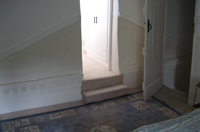
 Old Keepers:
Old Keepers:
A bricklayer's advertising hoarding?
The broken ground around Old Keepers is known to have been a brickfield. Up the hillside to the south of the cottage are abandonned clay workings. Behind the house is a large irregular mound, about two storeys high, which must have been a spoil heap. Today it is crowned with trees and shrubs.
The most prominent feature of the building itself is a double ‘pediment’ design in the brickwork across the front of the house, enclosing a decorative circle (see photograph, above). Did this once support the roof of another building, now gone? Or is it purely decorative?
THE SURVEY
The survey was completed in June 2011. It was immediately clear that Old Keepers was originally two cottages. not one. That to the north, which has the ‘pediment’, is smaller and set back. That to the south is larger and built on higher ground.
A doorway has been knocked through to connect the two cottages, but each retains its own separate staircase. That in the south cottage is a ‘winder’, set in a handsome staircase tower that has been added probably in the early 19th century.
But the most interesting internal feature is in the north cottage, where there is, on the inside of the rear wall, a second ‘pediment’ decoration in the brickwork. There are differences in design from that on the front of the house, but the two are clearly related.
This pediment was built to be seen. Its style would suit a brickmaker or bricklayer wishing to impress potential clients with the style and inventiveness of his brickwork. The cottages would have been a fine advertisement for this bricklayer's craft skills – and that is the most likely reason for the ‘pediments’.
THE DOCUMENTS
The Deeds of Old Keepers show that the first building on the site was put up between 1740, when ‘James Child, bricklayer’, bought an area of ground ‘near the Kiln’ and ‘lately in the possession of William Riggs Brickmaker’, and 1762, when he leased to James Hester ‘a small tenement or lean-to built by the aforesaid James Child’.
We can trace the ownership of buildings on the site through the documentary record for the next 200 years, and it is clear that there may have once been as many as four separate cottages on the site that is today Old Keepers, though only two survive.
THE REPORT:
• The full report, with detailed survey notes, measurements of the building, documentary references,
analysis, the two ‘pediments’, the dating of the building and its construction sequence can be downloaded here:
![]() Old Keepers, Hedgerley : BAS Report 2014-03 May 2014
Old Keepers, Hedgerley : BAS Report 2014-03 May 2014
PHOTOGRAPHS by Michael Rice
Click on each image to view an enlarged version.

|
The staircase tower |

|
The winder staircase |

|
The internal pediment |

|
An old fireplace |